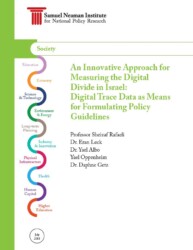In recent years, the study of digital divide is becoming increasingly important for policy formulation, as well as the evaluation of policy and interventions. A wide array of qualitative and quantitative methods has been used over the years to measure the scope of the digital divide between countries and various populations groups and to identify the main factors affecting it. These methods include surveys, structured interviews, open questionnaires and indicator analyses. While very useful and important, these “self-report” methods are obtrusive and very costly, thus unreplicable.
The traditional methods are prone to several weaknesses, They are, by-and-large one-shot studies, provide little continuous or even benchmark measures, and are subject to real sampling and self-report biases. In this project, we propose to apply a novel approach to improve the efforts to measure, analyze and visualize the digital divide in Israel by using unobtrusive digital trace data. These digital “footprints” are human and machine measures of digital activity (e.g. traffic bandwidth, likes, posts, blogs, instant messaging, search activity in search engines, e-purchases etc.).
Due to their on-demand availability, low cost, unlimited and constantly updated number of observations (population instead of sample), these unobtrusive digital trace measures could provide a powerful, dynamic and spatially detailed account of the spatial divide problem, crucial for the work of policy and decision makers at the national, regional and municipal levels. The outputs of the research will serve for policy formulation and policy evaluation purposes.


